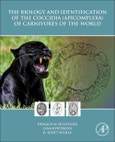The fundamental concept of The Biology and Identification of the Coccidia (Apicomplexa) of Carnivores of the World is to provide an up-to-date reference guide to the identification, taxonomy, and known biology of apicomplexan intestinal and tissue parasites of carnivores including, but not limited to, geographic distribution, prevalence, sporulation, prepatent and patent periods, site(s) of infection in the definitive and (if known) intermediate hosts, endogenous development, cross-transmission, pathology, phylogeny, and (if known) their treatments. These data will allow easy parasite recognition with a summation of virtually everything now known about the biology of each parasite species covered. The last (very modest) and only treatise published on this subject was in 1981 so this book fills a fundamental gap in our knowledge of what is now known, and what is not, about the coccidian parasites that infect and sometimes kill carnivores and/or their prey that can harbor intermediate stages, including many domestic and game animals.
Please Note: This is an On Demand product, delivery may take up to 11 working days after payment has been received.
Table of Contents
1. Introduction 2. Review Carnivore Evolution 3. Eimeriidae in the Caniformia Family Ailuridae 4. Eimeriidae in the Caniformia Family Canidae 5. Eimeriidae in the Caniformia Family Mephitidae 6. Eimeriidae in the Caniformia Family Mustelidae 7. Eimeriidae in the Caniformia Family Phocidae 8. Eimeriidae in the Caniformia Family Procyonidae 9. Eimeriidae in the Caniformia Family Ursidae 10. Eimeriidae in the Feliformia Family Felidae 11. Eimeriidae in the Feliformia Family Herpestidae 12. Eimeriidae in the Feliformia Family Hyaenidae 13. Eimeriidae in the Feliformia Family Viverridae 14. Adeleidae in the Carnivora 15. Sarcocystidae: Sarcocystinae in the Carnivora 16. Sarcocystidae: Toxoplasmatinae in the Carnivora 17. Cryptosporidiidae in the Carnivora 18. Treatment and Drug Therapies in Coccidiosis of Carnivora 19. Carnivores without Coccidia and Species Inquirendae 20. Discussion, Summary, and Conclusions








